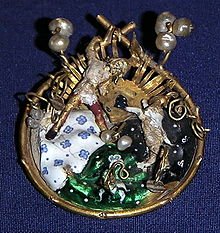Marsus bust
The bust of St. Marsus is a bust reliquary from around 1470/80 in the Essen Cathedral Treasury . It contained the skull of Marsus , a Roman priest and missionary who, according to tradition, worked in Gaul in the 3rd century AD .
description
The 46 cm life-size bust is of high quality and has naturalistic features. Marsus is shown bareheaded with a tonsure , the shape of which was used to attach an openable lid for the skull relic. The face is framed by inward curls, the head is tilted back and the gaze is raised. The head shows a detailed tension of the facial muscles, which gives the saint a vital expression to the viewer. He wears a Gothic chasuble with a chasuble cross placed on the front and back. The neck is covered by an amict with a parura , a decorated stand-up collar . The latter is, as is the cross Kasel, formed of a gold band to which alternating with plastic flower ornaments large gems and fine from four coral beads are placed composite crosses.
The bust is made of chased silver and is partially fire-gilded . The conclusion is one of bronze sheet molded, gilded pedestal on which Zargenfläche be simple floral Toolings find. Georg Humann saw this as a subsequent decoration. According to the style of the ornamentation, the base is a subsequent addition from the 17th century, possibly made for stabilization.
The bust is in good condition, there are only a few scratches and discolorations, which indicate minor repairs and cleaning attempts. A picture panel made by Humann reveals an earlier drawing of the pupil, which will have significantly increased the lively impression of the reliquary bust, but was removed during cleaning in the first half of the 20th century.
Votive offerings
For Marsus reliquary include as votive offerings 16 now separated from the bust also in the Essen Cathedral Treasury kept Burgundian clasps from around 1400, which is sewn on a red velvet were placed around the shoulders of the bust. They are made of gold and are decorated using the enamel technique . The pieces of jewelry belong to three stylistically different groups and were put together in the late Middle Ages to form a kind of necklace for the reliquary. Around 1900 they were separated from the reliquary and fixed on a board; today they are stored mounted on a plastic plate covered with silk. According to the treasury register of the Essen Minster of July 12, 1662, there were still 18 pieces. It is not known when the agraffes were added to the bust and who donated them.
Another attribute of the reliquary consisted of a silver heart, now lost, which was still hanging on a chain around the neck of the bust in a photograph by Georg Humann in 1904 and whose shape, according to Humann, points to the 14th century. According to the entry in the treasury register of 1662, it bore the inscription sanctus Marsus, ora pro me . Originally it was possibly donated as a votive offering for the lost Marsus shrine or for an older reliquary.
classification
The style of the Marsus bust in Essen is based on Westphalian works of the late 14th century, such as B. the silver-gilded busts and statuettes from the high altar of St. Paul's Cathedral in Münster , which were made between 1350 and 1380. Particularly striking physiognomic parallels can be found with the busts of Thomas , James the Elder , Bartholomew , Matthias , Philip and the Apostle Matthew , whose heads, however, are less differentiated due to their smaller format.
liturgy
The Marsus bust was of liturgical significance for the Essen monastery . As a very plastic, life-size depiction of saints, Marsus became a person who was personally tangible for the believer. This dimension of the encounter could not be guaranteed by the Marsus Shrine, which was already over five hundred years old. In this way, the monastery made it possible to experience the martyr's presence much better in processions , which in the late 15th century ultimately led to a pronounced veneration of Marsus, of which the treasure bears clear evidence that we cannot find in the written sources today.
literature
- Georg Humann : The works of art of the cathedral church to eat. Schwann, Düsseldorf 1904, pp. 367-369.
- Klaus Gereon Beuckers : The Marsus Shrine in Essen. Investigations into a lost major work of Ottonian goldsmithing (= Institute for Research on Church History of the Diocese of Essen. Sources and Studies. Volume 12). Aschendorff, Münster 2006, ISBN 3-402-06251-8 , pp. 25-34.
- Birgitta Falk (ed.): The Essen Cathedral Treasure. Klartext Verlag, Essen 2009, ISBN 978-3-8375-0200-8 , p. 136 No. 51.
Web links
- Bust of St. Marsus on the pages of the Essen Cathedral Treasury
Individual evidence
- ↑ Georg Humann: The works of art of the Münsterkirche to Essen. Düsseldorf 1904, p. 36 note 3.
- ↑ Birgitta Falk: The sixteen Franco-Burgundian agraffes in the Essen cathedral treasure. In: Birgitta Falk, Thomas Schilp, Michael Schlagheck (eds.): ... how the gold shines in the eyes. Treasures from the Essen women's foundation (= Essen research on the women's foundation. Vol. 5). Klartext-Verlag, Essen 2007, ISBN 978-3-89861-786-4 , pp. 215–241; Susanne Conrad: 16 agraffes from the Essen cathedral treasure. In: Yearbook of the Rhenish Preservation of Monuments 42, 2011, pp. 240–243.
- ↑ Klaus Gereon Beuckers: The Essen Marsus shrine. Investigations into a lost masterpiece of the Ottonian goldsmith's art. Münster 2006, p. 30.

